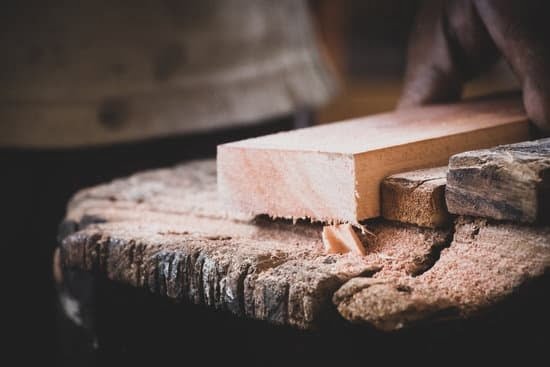When it comes to woodworking, the right wood is crucial in creating stable and durable projects. But what about the wood used to support these creations?
In this ultimate guide, we will dive into the world of support wood for woodworking and explore the various factors that need to be considered when selecting the ideal wood. From understanding the different types of support wood to examining popular options and specialized choices for specific projects, we will provide you with comprehensive knowledge to elevate your woodworking craftsmanship.
Choosing the right support wood is of utmost importance as it ensures stability and durability in your woodworking projects. Without proper support, even the most well-crafted pieces can become weak or prone to damage over time. That’s why it’s essential to understand the different types of support wood available and their advantages.
Softwoods, such as pine, offer versatility and affordability, while hardwoods excel in providing stability. By understanding these differences, you can make informed decisions about which type of support wood suits your specific needs.
In addition to considering the type of wood, there are other crucial factors that need to be taken into account when selecting support wood for woodworking projects. Weight capacity should be matched with your project’s requirements to ensure adequate strength. Moisture resistance is vital in protecting your investments from unwanted damage caused by moisture-related issues.
Evaluating workability helps determine how easy it is to work with different types of support wood during construction. Considering all these factors will enable you to choose the ideal support wood that meets your specific needs.
By exploring popular options like plywood, MDF (Medium-Density Fiberboard), and solid pine, you’ll gain insights into their pros and cons for woodworking support structures. Additionally, we will delve into specialized support woods such as marine plywood and Baltic birch that cater specifically to outdoor applications or fine woodworking precision and strength respectively. Each option has its own unique characteristics that may align better with certain projects or preferences.
Furthermore, we will provide tips and techniques for working with support wood, including joinery methods for reinforcing support structures, cutting techniques for accurate dimensions, and finishing touches to protect and enhance the appearance of your support wood. These skills are essential in ensuring the long-term stability and aesthetic appeal of your woodworking projects.
By the end of this guide, you will be equipped with the knowledge necessary to make informed decisions about selecting the ideal support wood for your woodworking endeavors. Elevate your craftsmanship to new heights by utilizing the right choice of support wood that matches both the technical requirements and creative vision of your projects.
The Importance of Choosing the Right Support Wood
The stability and durability of a woodworking project greatly depend on the choice of support wood. Selecting the right support wood is crucial to ensure proper structural integrity, prevent warping or sagging, and ultimately enhance the longevity of your creation.
The Significance of Stability
When it comes to woodworking projects, stability plays a vital role in ensuring their overall strength. Choosing the appropriate support wood can provide a solid foundation for your project, preventing any potential issues that may arise from using weak or insufficient materials. Additionally, stability also helps in maintaining the dimensional accuracy and structural integrity of your woodworking creations.
Durability as a Key Factor
Durability is another important aspect to consider when selecting support wood. Woodworking projects often require materials that can withstand various environmental conditions and resist wear and tear over time. By choosing a durable support wood, you can enhance the longevity of your projects and reduce the need for frequent repairs or replacements.
Selection Considerations
To determine the ideal support wood for your woodworking projects, several factors should be taken into consideration.
Weight Capacity: It is essential to match the strength of the selected support wood with the weight requirements of your project. Heavy-duty applications will require stronger woods such as hardwoods or marine plywood, while lighter loads may be adequately supported by softer woods.
Moisture Resistance: If your project will be exposed to moisture or high humidity levels, it is crucial to choose a support wood that has good resistance to water damage. Moisture-resistant woods like marine plywood or certain hardwoods are ideal for outdoor applications or areas prone to moisture.
Workability: The ease with which you can work with different types of support wood is also important to consider. Some woods may be harder or more challenging to shape, cut, or join compared to others. Evaluating this factor can help you choose a support wood that aligns with your woodworking skills and comfort level.
By carefully considering the stability, durability, weight capacity, moisture resistance, and workability of various support wood options, you can make an informed decision that will contribute to the success of your woodworking projects.
Understanding the Different Types of Support Wood
Wood is a versatile material that requires careful consideration when choosing the right support wood for woodworking projects. Understanding the different types of support wood available can help ensure stability and durability in your creations. This comprehensive overview will provide you with valuable information on the various options and their advantages.
In woodworking, two main categories of support wood are commonly used: softwoods and hardwoods. Softwoods, such as pine and cedar, have several advantages when utilized in support structures. They are lightweight, making them easier to work with and transport. Additionally, softwoods have natural characteristics that make them resistant to shrinking and swelling caused by fluctuations in temperature and humidity.
On the other hand, hardwoods are renowned for their strength and stability, making them ideal for providing robust support in woodworking projects. Hardwood varieties like oak, walnut, and maple offer excellent dimensional stability and can withstand heavy loads without bending or warping. They also have a beautiful natural appearance and can be finished to enhance their aesthetic appeal.
When selecting the ideal support wood for your woodworking projects, there are several factors to consider. First, determine the weight capacity required for your specific project. Matching the strength of your support wood to the demands of your creation will ensure its long-term durability. Additionally, considering moisture resistance is crucial to protect your investment from unwanted damage caused by moisture infiltration or environmental conditions.
Finally, evaluating the workability of different types of support wood is essential to ensure ease in cutting, shaping, and joining pieces together. Some woods may be harder or more challenging to work with than others due to their density or grain patterns. Understanding these aspects will help you select a suitable option that aligns with your project requirements.
Factors to Consider When Selecting the Ideal Support Wood
When it comes to selecting the ideal support wood for your woodworking projects, there are several important factors to consider. These factors include weight capacity, moisture resistance, and workability. Each of these considerations plays a crucial role in ensuring the stability and durability of your woodworking structures.
Determining Weight Capacity: Matching the Support Wood Strength to your Project’s Requirements
Weight capacity is a critical factor to consider when selecting support wood for your woodworking projects. Choosing a wood with inadequate strength can result in structural issues and potential accidents. On the other hand, using overly strong or heavy wood may not be necessary and can add unnecessary weight to your project.
To determine weight capacity, you should assess the load-bearing requirements of your project and choose a support wood that matches those requirements. Different types of woods have varying strength characteristics, so it is essential to research and understand the strength properties of different species before making a selection.
Moisture Resistance: Protecting Your Woodworking Investments from Unwanted Damage
Moisture resistance is another crucial consideration for support wood selection. Wood exposed to high levels of moisture can be susceptible to rot, decay, warping, and other forms of damage. It is vital to choose a wood species that offers sufficient natural resistance to moisture or one that can be effectively treated to enhance its moisture resistance.
Certain woods naturally possess higher levels of moisture resistance due to their inherent characteristics or natural oils present in their composition. Alternatively, you can opt for pressure-treated lumber that has been treated with chemicals designed specifically for preservation against moisture-related issues.
Workability: Evaluating the Ease of Working with Different Types of Support Wood
Workability refers to how easily a particular wood can be shaped, cut, joined, and manipulated during woodworking processes. The workability of support wood is an essential consideration as it affects both the efficiency of your woodworking projects and the quality of the final product.
Different wood species vary in their workability characteristics. Some woods may be more prone to splintering, while others may be challenging to cut or shape precisely. It’s important to select a support wood that suits your tools, skills, and the specific requirements of your project.
Considering weight capacity, moisture resistance, and workability will help you make an informed choice when selecting the ideal support wood for your woodworking projects. By carefully evaluating these factors, you can ensure that your support structures are not only stable and durable but also efficiently designed to meet the needs of your woodworking craftsmanship.
| Factors to Consider | Description |
|---|---|
| Weight Capacity | Determining the strength of support wood based on load-bearing requirements |
| Moisture Resistance | Selecting wood species that offer natural resistance or can be treated for moisture protection |
| Workability | Evaluating how easily a particular wood can be shaped, cut, and manipulated during woodworking processes |
Popular Support Wood Options for Woodworking Enthusiasts
a. Plywood: The Versatile All-Rounder for Woodworking Support Structures
Plywood is a popular choice among woodworking enthusiasts when it comes to support wood options. It is made up of several layers or plies of thin wood veneers that are glued together, creating a strong and durable material. One of the main advantages of plywood is its versatility. It comes in various thicknesses and grades, allowing you to choose the right option based on your project’s requirements.
One of the key pros of plywood is its strength. Its cross-laminated construction gives it excellent structural integrity and makes it resistant to warping or twisting, providing stability and support to your woodworking projects. Additionally, plywood generally has good screw-holding capacity, making it suitable for joining and securing other pieces of wood.
However, one aspect to consider when using plywood as support wood is its vulnerability to moisture. Unless treated or sealed properly, plywood can be susceptible to water damage, which can weaken its structure over time. Therefore, if you’re planning on using plywood in outdoor or potentially damp conditions, it’s important to take precautions such as applying a waterproof finish or opting for marine-grade plywood.
b. MDF (Medium-Density Fiberboard): A Cost-Effective and Stable Solution for Support Wood
Another popular choice for woodworking support structures is Medium-Density Fiberboard (MDF). MDF is engineered from fine wood fibers combined with a resin binder under high pressure and heat. This manufacturing process results in a dense and uniform material that provides consistent strength throughout.
One advantage of MDF is its cost-effectiveness. Compared to other types of solid wood or even plywood, MDF tends to be more budget-friendly while still offering stability and durability. It also has smooth edges that make it easy to work with and finish.
However, moisture resistance is not one of MDF’s strengths. MDF is highly absorbent and can quickly swell or warp when exposed to water or high humidity. As a result, it’s crucial to protect MDF from moisture by applying sealants or using it in indoor projects where exposure to water is minimized.
c. Solid Pine: An Affordable and Widely Available Option for Woodworking Support
Solid pine is a commonly used support wood option due to its affordability and widespread availability. Pine is a softwood, which means it’s relatively easy to work with and manipulate. It offers good structural strength for many woodworking projects while being more cost-effective compared to hardwoods.
One of the advantages of solid pine is its weight capacity. It can support moderate loads and is suitable for most general woodworking applications. However, if you’re planning on building heavy-duty structures or expecting significant weight-bearing requirements, you may need to consider stronger support wood options such as hardwoods or plywood.
It’s important to note that solid pine has natural variations in color and grain patterns, which can add character to your woodworking projects. However, these variations may also require extra attention during finishing stages to achieve a smooth and consistent appearance.
Specialized Support Wood for Specific Woodworking Projects
When it comes to woodworking, one size does not fit all. Different projects require different types of support wood to ensure stability and durability. In this section, we will explore some specialized support wood options that are tailored to specific woodworking projects.
One popular option for outdoor and marine applications is marine plywood. Marine plywood is specially designed to withstand exposure to moisture and harsh weather conditions. It is made with waterproof glue and constructed using more durable wood species, making it highly resistant to rotting and warping. Whether you’re building a boat or an outdoor structure exposed to the elements, marine plywood is an excellent choice for its strength and longevity.
For fine woodworking projects that require precision and strength, Baltic Birch is a go-to option. Baltic Birch is known for its smooth surface, consistent thickness, and exceptional multi-layered construction. It offers superior stability, making it ideal for intricate joinery work or projects that demand high-quality craftsmanship. Whether you’re creating decorative furniture or intricate wooden boxes, Baltic Birch will elevate the overall aesthetic appeal and durability of your project.
It’s important to note that specialized support wood options may come at a higher price compared to other alternatives. However, their unique qualities make them worth considering for specific woodworking projects where performance matters most.
Tips for Working with Support Wood
Working with support wood in woodworking projects requires proper techniques for joining, cutting, and finishing to ensure the structural integrity and aesthetic appeal of the final piece. In this section, we will explore some tips and techniques that can help elevate your woodworking craftsmanship when working with support wood.
When it comes to joining support wood structures, there are various methods you can use to reinforce the joints and enhance their strength. One popular technique is using woodworking joinery methods such as mortise and tenon, dovetail, or biscuit joints. These methods create strong connections between the pieces of support wood and provide stability to the overall structure. Additionally, using wood glue along with the joinery method can further strengthen the joint.
Cutting support wood accurately and precisely is crucial for achieving clean edges and tight-fitting pieces. Using measuring tools like a tape measure or combination square can help ensure precise measurements. When making cuts, it’s essential to use sharp cutting tools such as a table saw or circular saw and follow a straight edge guide for straight cuts. For curved cuts or intricate designs, a jigsaw or coping saw can be used effectively.
Finishing touches on support wood not only protect it from moisture damage but also enhance its appearance. Before applying any finish, make sure to sand the surface of the support wood to achieve a smooth finish free of imperfections. Then, choose an appropriate finish based on your project’s requirements. Options include varnish, polyurethane, lacquer, or paint. Applying multiple coats of finish evenly with a brush or sprayer will provide better protection and a more professional appearance.
By implementing these techniques for joining, cutting, and finishing support wood in your woodworking projects, you can ensure that your structures are sturdy, visually appealing, and long-lasting. Taking the time to master these skills will contribute greatly to elevating your overall woodworking craftsmanship and satisfaction in creating beautiful pieces of functional artistry.
Conclusion
In conclusion, choosing the right support wood is crucial for achieving stability and durability in your woodworking projects. By understanding the different types of support wood and considering factors such as weight capacity, moisture resistance, and workability, you can make an informed decision that will enhance your craftsmanship.
Softwoods offer advantages in woodworking support structures due to their natural characteristics such as flexibility and ease of shaping. On the other hand, hardwoods excel in providing stability and strength, making them ideal for projects that require heavy load-bearing capabilities.
When selecting support wood, it is important to consider the specific requirements of your project. Determining weight capacity ensures that you choose a support wood with sufficient strength to bear the load. Moisture resistance protects your woodworking investments from damage caused by changes in humidity or exposure to water. Lastly, evaluating the workability of different types of support wood allows you to choose one that is easy to shape and manipulate.
Popular options for support wood include plywood, MDF (Medium-Density Fiberboard), and solid pine. Each option has its own pros and cons, so it’s important to weigh them against your project’s needs before making a decision. Additionally, specialized support woods like marine plywood and Baltic birch are available for specific applications where enhanced durability or precision is required.
In order to elevate your woodworking craftsmanship even further, it’s essential to learn techniques for working with support wood. This includes mastering joinery methods for reinforcing structures, using cutting techniques that ensure accurate dimensions, and applying finishing touches to protect and enhance the appearance of your support wood.
By carefully considering all these factors and making informed choices about your support wood, you can elevate your woodworking projects to new heights. The right choice of support wood will not only ensure stability and durability but also enhance the overall aesthetics of your creations. So when embarking on your next woodworking adventure, remember the importance of selecting the ideal support wood that matches both your project’s requirements and your own creative vision.

Hi everyone! I’m a woodworker and blogger, and this is my woodworking blog. In my blog, I share tips and tricks for woodworkers of all skill levels, as well as project ideas that you can try yourself.





